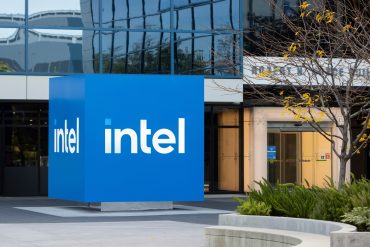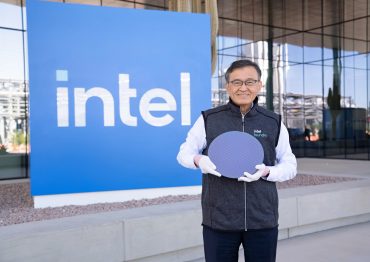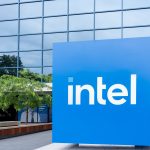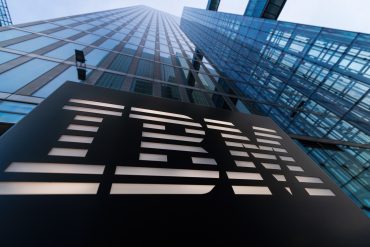
- AI Infrastructure
- Earnings Season
- Semiconductors
Intel Q3 Results: Stabilization, Foundry Shift, and Federal Backing
8 minute read

Intel posts $13.7 billion revenue and first positive free cash flow in five quarters as Nvidia and U.S. federal capital anchor its foundry and AI pivot.
Key Takeaways
-
Revenue stabilizes with margin recovery — Intel delivered $13.7 billion, up 3 percent YoY, as GAAP gross margin expanded to 38.2 percent, turning free cash flow positive after five consecutive negative quarters.
-
Strategic alliances reinforce credibility — Nvidia’s $5 billion equity stake and SoftBank’s $2 billion investment validate Intel’s 18A process and foundry ambitions, while Microsoft’s custom-silicon deal confirms commercial viability.
-
Federal support drives capacity scale-up — The $8.9 billion CHIPS Act package and $5.7 billion Q3 disbursement fund U.S. fabs projected to capture 15–20 percent of global AI-chip demand by 2030, underpinning industrial-policy momentum.
Introduction
In the unforgiving arena of semiconductor supremacy, where geopolitical imperatives and technological disruption intersect, Intel’s third-quarter 2025 results represent a deliberate step toward equilibrium rather than explosive rebound. Revenues reached $13.7 billion, a 3 percent year-over-year increase from $13.3 billion, reflecting cost discipline and selective demand recovery in a market still shadowed by inventory corrections and export restrictions. This modest advance, coupled with GAAP gross margin expansion to 38.2 percent—up 23.2 percentage points—signals not mere recovery from prior impairments but foundational recalibration, where operating losses narrowed and free cash flow turned positive for the first time in five quarters.
For senior investors weighing exposure to the $600 billion foundry ecosystem and policymakers navigating U.S. manufacturing resurgence, these metrics illuminate Intel’s pivot: from beleaguered incumbent to fortified contender, leveraging federal support and strategic alliances to reclaim positioning in AI compute and domestic fabrication. The quarter’s defining narrative centers on stabilization—cost structures rationalized, balance sheet fortified, and strategic partnerships crystallized—rather than growth acceleration. Yet beneath this measured progress lies a more consequential transformation: Intel’s evolution from integrated device manufacturer to foundry operator capable of serving both captive needs and external customers, a shift that carries profound implications for global semiconductor supply chains.
Key Developments
The Client Computing Group, Intel’s enduring revenue foundation at $8.5 billion—up 5 percent year-over-year—anchors this narrative, driven by steady commercial PC demand where vPro platforms integrate AI acceleration for endpoint security and remote management. This resilience stems from bifurcated demand dynamics: consumer softness persists amid economic uncertainty, yet enterprise refresh cycles—accelerated by hybrid work requirements—sustain volumes, with Lunar Lake processors delivering 40 percent improved graphics performance, according to internal benchmarks. The segment’s stability belies intensifying competitive pressure; as AMD and Qualcomm advance with custom silicon for original equipment manufacturers, Intel’s x86 architecture, now augmented by neural processing units in Core Ultra series, becomes a critical differentiator.
The Data Center and AI segment presented a more complex picture at $4.1 billion—down 1 percent year-over-year—where macroeconomic headwinds affecting cloud hyperscalers obscure nascent inflection points. Inventory digestion in enterprise servers, exacerbated by prior capacity overbuilds, tempered growth, yet Gaudi 3 accelerators posted sequential gains, underscoring Intel’s application-specific integrated circuit strategy as a counterweight to Nvidia’s CUDA ecosystem dominance. The quarter’s marquee development—a multigenerational collaboration with Nvidia to co-design custom data center and PC silicon—represents pragmatic détente, blending Intel’s fabrication capabilities with Nvidia’s software infrastructure to target AI inference workloads.
This alliance, alongside Nvidia’s $5.0 billion equity investment, injects not merely capital but credibility, signaling to investors that Intel’s 18A process—now yielding wafers at Fab 52 in Arizona—can deliver 20-30 percent power efficiency improvements over TSMC’s N2 node in joint prototype evaluations. For policymakers, it exemplifies CHIPS Act leverage: the $8.9 billion federal agreement, with $5.7 billion disbursed this quarter, underwrites domestic capacity projected to capture 15-20 percent of global AI chip demand by 2030, mitigating supply-chain vulnerabilities exposed by U.S.-China technological competition.
Network and Edge operations, bundled within Intel Products at a collective $12.7 billion (up 3 percent), offered measured contributions, with edge computing advancing on 5G deployments but constrained by automotive sector cyclicality. Intel Foundry Services, at $4.2 billion (down 2 percent), encapsulates the quarter’s strategic tension: external customer production ramps, including Microsoft’s Azure infrastructure builds, offset internal demand softness, yet intersegment eliminations of $4.2 billion highlight the structural complexities in a model where captive manufacturing subsidizes merchant ambitions.
Mobileye’s divestiture proceeds—$5.2 billion from the Altera stake sale—bolstered “all other” revenues to $1.0 billion (up 3 percent), providing non-dilutive liquidity that underscores Intel’s portfolio rationalization: divesting non-core assets to fund commitments exceeding $90 billion in capital expenditures through 2027. This discipline manifests in profitability metrics: GAAP operating expenses declined 20 percent to $4.4 billion, yielding a 5.0 percent margin—up 73.2 percentage points—while non-GAAP figures reached 11.2 percent, reflecting research and development efficiencies in 18A process validation and one-time impairment reversals.
Net income attributable to Intel swung to $4.1 billion on a GAAP basis (up 124 percent) and $1.0 billion non-GAAP, with diluted earnings per share at $0.90 and $0.23, respectively—a reversal that, while influenced by accounting adjustments, affirms cost reduction initiatives taking effect.

Market Impact
Cash generation, long Intel’s structural weakness, marked a meaningful inflection: operating cash flow of $2.5 billion underpinned positive free cash flow, reversing prior cash consumption and expanding cash equivalents to $11.1 billion alongside $19.8 billion in short-term investments. Total assets stood at $204.5 billion, with property, plant, and equipment at $105.0 billion—testament to fabrication expansions in Ohio and Arizona—against $46.6 billion in debt and $116.7 billion in equity. SoftBank’s $2.0 billion stock investment further diversifies the capital structure, enhancing flexibility for the company’s capital allocation framework. CFO David Zinsner characterized this financial fortification directly: “We took meaningful steps this quarter to strengthen our balance sheet… Our stronger than expected Q3 results mark our fourth consecutive quarter of improved execution and reflect the underlying strength of our core markets. Current demand is outpacing supply, a trend we expect will persist into 2026”
From an analytical perspective, this liquidity—amplified by Altera proceeds—affords Intel the capacity to absorb 18A yield curve progression, projected at 90 percent by mid-2026, without equity dilution, a critical hedge against the capital intensity plaguing foundry competitors.
The market’s reception proved measured rather than euphoric, reflecting investor recognition that stabilization differs from transformation. Intel’s forward earnings multiple of 12-15 times positions the stock at a discount to historical norms, embedding skepticism about foundry economics materialization timelines and competitive positioning against TSMC’s established node leadership. Yet this valuation incorporates limited credit for potential upside scenarios: successful 18A commercialization could unlock Intel Foundry Services gross margins approaching 40 percent by 2027 on external customer volume ramps, while AI adjacencies through Gaudi accelerators and inference-optimized processors offer diversification beyond traditional x86 franchise economics.
Strategic Insights
Forward guidance introduces near-term caution: fourth-quarter revenues projected at $12.8 billion to $13.8 billion, with non-GAAP gross margins at 36.5 percent and earnings per share at $0.08, excluding Altera’s residual impact. Full-year trajectories imply flat-to-low-single-digit growth, but strategic catalysts accumulate: the unveiling of Panther Lake system-on-chips on 18A process technology, promising 15 percent instructions-per-clock improvements for client AI applications; Xeon 6+ (Clearwater Forest) with 2.5 times inference throughput enhancements; and the Crescent Island GPU targeting enterprise token generation workloads in a $50 billion addressable inference market segment.
CEO Lip-Bu Tan framed the outlook with characteristic precision:
Our Q3 results reflect improved execution and steady progress against our strategic priorities. AI is accelerating demand for compute… Intel’s industry-leading CPUs and ecosystem, along with our unique U.S.-based leading-edge logic manufacturing and R&D, position us well to capitalize on these trends over time
These developments carry ecosystem implications. For investors, Intel’s third quarter validates a thesis predicated on foundry economics diversification and AI infrastructure positioning rather than x86 market share defense alone. The Nvidia partnership represents strategic pragmatism—acknowledging that semiconductor value chains increasingly reward specialized collaboration over vertical integration absolutism. By fabricating Nvidia-designed silicon while simultaneously competing in accelerator markets through Gaudi, Intel demonstrates portfolio flexibility that could prove essential as AI workload architectures fragment across training, inference, and edge deployment models.
Policymakers discern validation of industrial policy frameworks: the CHIPS Act’s $8.9 billion commitment not only subsidizes approximately 20,000 manufacturing jobs but enforces geographic diversification of leading-edge capacity, countering TSMC’s Arizona presence with Intel’s vertically integrated domestic footprint. This strategic depth carries national security dimensions beyond pure economics—ensuring that critical compute infrastructure for defense, intelligence, and commercial applications maintains domestic sourcing optionality independent of geopolitical contingencies affecting Taiwan Strait stability.
Business leaders confronting AI infrastructure build-outs find in Intel’s ecosystem—spanning silicon architecture to software optimization—a hedge against single-vendor concentration risks. The Nvidia equity stake, rather than signaling capitulation, indicates collaborative abundance logic superseding zero-sum competition paradigms. As AI compute demand scales exponentially—training clusters now consuming gigawatts of power and billions in capital—supply chain resilience and vendor diversification become existential concerns that Intel’s foundry expansion directly addresses.

Data and Forward Outlook
The quarter’s financial architecture reveals granular inflection points. Client Computing’s 5 percent growth, while modest, sustains the cash generation engine that funds foundry transformation—a dynamic where mature product cash flows subsidize nascent process technology development. Data Center and AI’s 1 percent decline masks compositional shifts: traditional server processor volumes contracted amid hyperscaler digestion cycles, yet AI accelerator revenues inflected positively, suggesting early traction in markets where Intel historically held negligible presence.
Intel Foundry Services’ external customer revenue growth, though obscured by intersegment accounting, represents the quarter’s most consequential leading indicator. Microsoft‘s decision to fabricate Azure custom silicon at Intel fabs validates technical credibility at commercial scale, providing reference customers that could catalyze broader design win pipelines. The $4.2 billion in intersegment eliminations—captive production for Intel’s own product groups—demonstrates that foundry operations already support substantial internal demand, establishing utilization floors that reduce merchant customer concentration risks.
Capital allocation priorities crystallize through asset disposition and investment patterns. The Altera divestiture, yielding $5.2 billion, exemplifies portfolio optimization—monetizing programmable logic assets at attractive multiples while redeploying proceeds toward higher-return fabrication capacity and AI silicon development. Property, plant, and equipment expansion to $105.0 billion reflects committed capital deployment rather than speculative capacity addition, with fab construction timelines synchronized to customer commitment roadmaps and process technology maturation milestones.
Balance sheet fortification through external capital infusions—Nvidia’s $5.0 billion equity investment and SoftBank’s $2.0 billion stake—demonstrates investor confidence in the foundry transformation thesis while avoiding dilutive equity raises. This capital structure approach, blending strategic partnerships with organic cash generation and selective asset sales, provides financial flexibility to absorb execution risks inherent in simultaneous process technology transitions and business model evolution.
Conclusion
Intel’s third quarter positions the company at an inflection point: fundamentally stabilized, strategically repositioned through critical alliances, yet vulnerable to execution challenges in 18A scaling and demand trajectory uncertainties. The quarter validates neither bullish transformation narratives nor bearish structural decline scenarios; instead, it evidences methodical progress toward a reconfigured competitive positioning predicated on foundry services diversification, AI infrastructure participation, and geographically diversified leading-edge capacity.
For institutional investors, the opportunity lies not in explosive near-term growth but in asymmetric risk-reward dynamics: current valuations embed substantial skepticism about foundry strategy viability, yet successful execution could unlock material margin expansion and revenue diversification that justify significant multiple re-rating. The Nvidia partnership and federal capital commitments reduce tail risks while establishing credibility markers that could accelerate external customer adoption cycles.
Policymakers observe tangible returns on industrial policy investment: domestic fabrication capacity scaling toward operational reality, technology leadership in advanced nodes maintaining competitive proximity to offshore alternatives, and workforce development initiatives establishing sustainable manufacturing ecosystems beyond construction phase employment spikes.
Business leaders gain strategic optionality through vendor diversification and domestic sourcing alternatives, particularly valuable as geopolitical fragmentation increasingly constrains global supply chain configuration choices.
Intel emerges from this quarter not as the unchallenged semiconductor leader it once was, but as a reconstituted competitor equipped with federal backing, strategic partnerships, and operational discipline sufficient to contest leadership in an industry where technological flux and geopolitical realignment have rendered legacy advantages obsolete. The forge yields not dominance, but durability—a foundation upon which sustainable competitiveness can be constructed through disciplined execution and strategic clarity. For capital allocators weighing semiconductor exposure, that foundation merits serious consideration.







